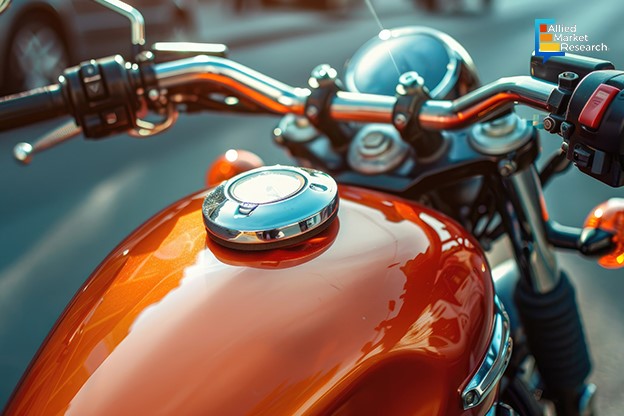Advances in Materials and Design Revolutionizing 2-Wheeler Fuel Tanks

13 Mar
2025
Highlights:
- A brief on 2-wheeler fuel tanks
- Promising use cases of these tanks in vehicle manufacturing
- Sustainable product launches by key players in the domain
Motorcycles are globally renowned for their lightweight design and speed, making them a preferred mode of transportation. For fuel-powered motorcycles, the fuel tank is an important element of the vehicle's design and a key component that ensures smooth operation. These tanks are typically made from durable materials such as aluminum or steel and are positioned at the center or rear of the vehicle. They are engineered to hold a substantial amount of fuel, allowing for extended trips without the need for frequent refueling.
Understanding the structure and materials used in fuel tanks
The capacity of 2-wheeler fuel tanks widely varies, with common sizes ranging from less than 5 liters to above 15 liters. The most prevalent segment in the market includes tanks with capacities of less than 20 liters. For example, the Honda Grom has a fuel tank capacity of approximately 5.5 liters, with an average fuel consumption of about 2.3 liters per 100 kilometers. In contrast, larger scooters like the NSS350 have bigger fuel tanks but may consume twice as much fuel as the Grom.
The range of a motorcycle depends on its fuel consumption, which is influenced by several factors including engine displacement, vehicle weight, aerodynamic drag, driving habits, road conditions, and the efficiency of the transmission system. Therefore, when selecting a motorcycle, it's important to consider personal circumstances rather than solely focusing on a larger fuel tank.
Fuel tanks for two-wheelers are commonly made from galvanized steel, aluminum alloy, and other metals due to their strength, durability, and resistance to corrosion. Metal fuel tanks, specifically, offer significant advantages in terms of durability and impact resistance, providing enhanced protection during accidents. However, they are heavier, which increases the overall weight of the motorcycle.
In the last few years, advancements in technology have fueled the growth of the 2-wheeler fuel tank industry. This has led to an increased use of engineering plastics, such as polyethylene (PE), in motorcycle fuel tanks. These materials are lightweight and exhibit strong corrosion resistance and impact resistance, effectively prolonging the lifespan of the tank. Plastic tanks offer several benefits compared to metal tanks. They are less expensive and offer superior design flexibility due to better molding capabilities.
Key roles of two-wheeler fuel tanks beyond fuel storage
In addition to storage, motorcycle fuel tanks play a key role in supplying fuel to the engine. It uses a fuel pump and fuel lines to deliver fuel to the engine nozzle, ensuring smooth operation of the motorcycle. The efficiency of this fuel supply system directly impacts the power output and fuel economy of the motorcycle. Furthermore, the fuel tank contributes to heat dissipation by allowing gasoline to flow through the fuel lines, which helps reduce engine temperatures. Further, different fuel tank shapes and colors enhance the look of two-wheelers, making them a key part of the design.
Bajaj Auto introduced the world’s first CNG motorcycle
In July 2024, Bajaj Auto Ltd., an Indian multinational automotive manufacturing company launched the world’s first CNG motorcycle, the Freedom, in India, priced between ₹95,000 and ₹1,10,000. It features a 2kg CNG tank and a 2-litre petrol tank, powered by a 125cc petrol engine. Additionally, it offers 102 km/kg on CNG and 65 km/l on petrol, cutting overall running costs by half. Bajaj also urged the government to reduce GST on two-wheelers from 28% to 12% to boost affordability of two-wheelers.
Endnote
In conclusion, motorcycle fuel tanks are essential components that ensure smooth operation and aesthetic appeal of modern two-wheelers. The increasing use of plastic tanks has offered greater durability, efficiency, and a new look. Moreover, with the rise in focus on sustainable vehicle design, many manufacturers have started designing CNG motorcycles to lower environmental impact significantly.
For more insights into the latest materials used in designing these fuel tanks, feel free to talk to our industry specialists today!

Koyel Ghosh
Author’s Bio- Koyel Ghosh is a blogger with a strong passion and enjoys writing in miscellaneous domains, as she believes it lets her explore a wide variety of niches. She has an innate interest in creativity and enjoys experimenting with different writing styles. A writer who never stops imagining, she has been serving the corporate industry for the last five years.
Avenue: Entire Library membership of Allied Market Research Reports at your disposal
- Avenue is an innovative subscription-based online report database.
- Avail an online access to the entire library of syndicated reports on more than 2,000 niche industries and company profiles on more than 12,000 firms across 11 domains.
- A cost-effective model tailored for entrepreneurs, investors, and students & researchers at universities.
- Request customizations, suggest new reports, and avail analyst support as per your requirements.
- Get an access to the library of reports at any time from any device and anywhere.
Related Post
-
How are Submarine Cables Transforming Global Connectivity with Enhanced User Experience?
-
Endoscopy Procedures: Transformations in Techniques and Applications
-
AI-Powered Video Analytics: How the Product Actually Works for enterprises
-
Painting Robots: Transforming Precision Coating and Creative Applications
-
Innovations in Pharmacovigilance Systems Advancing Patient Safety
-
Understanding Edge Security: Keeping Data Safe Near the Source
-
Exploring the Use and Advancements of 3D Laser Scanners in Professional Applications
-
Reinforcing Industrial Controls with Smarter Tools and Training








